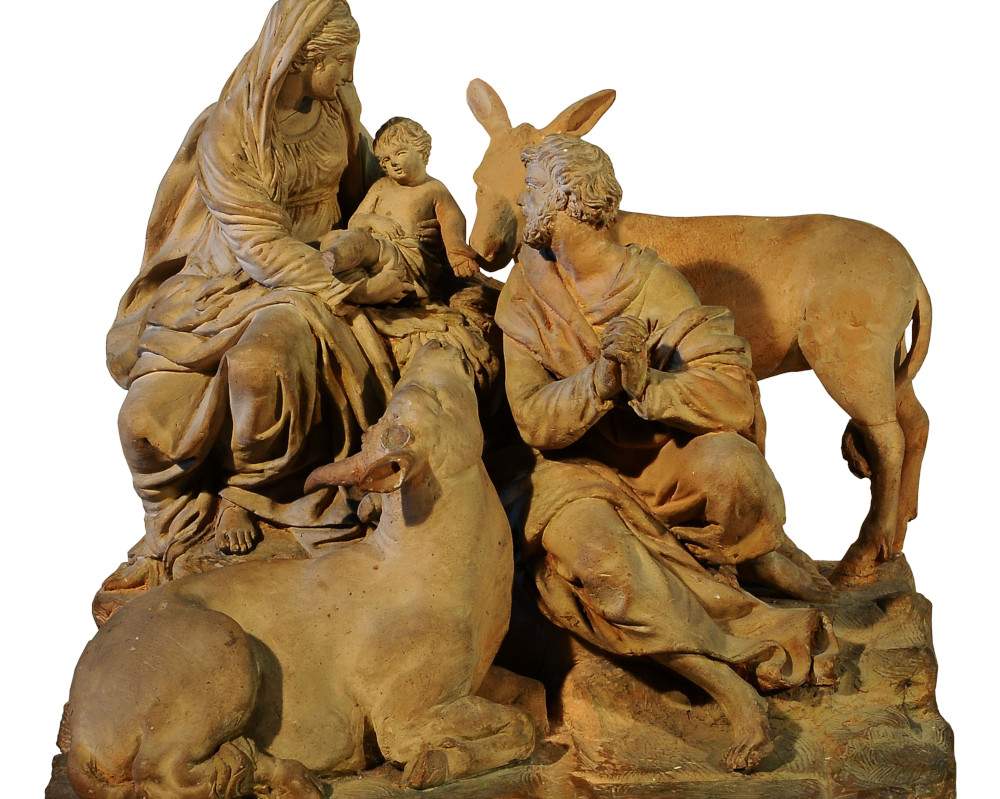Unpublished terracotta nativity scene by Pietro Righi on display in Bologna
Until Jan. 15, 2023, the Museo Civico d’Arte Industriale e Galleria Davia Bargellini ’s “exemplary” nativity scene by Pietro Righi (Bologna, 1772-1839) is on view at the Museo Civico d’Arte Industriale e Galleria Davia Bargellini: an unprecedented terracotta Nativity group with remarkable modeling quality, from a private collection. The back of the terracotta sculpture reads "Pietro Righi/ Fece/ L’anno 1826/Li 4 ottobre/n° 5.
The exhibition of the sculpture to the public for the first time is an opportunity to bring together, in close dialogue with each other, two other specimens by the hand of the same Righi having the same material and iconographic type, already present in the rich collection of ancient Bolognese crib pieces preserved in the museum.
The three pieces, thus placed side by side, represent a significant testimony to the nativity statuary made by Pietro Righi, an exponent of a generation heir to the great Bolognese master plasticists such as Giuseppe Maria Mazza (1653-1741), Angelo Gabriello Piò (1690-1770) and Filippo Scandellari (1717-1801). Although he did not reach the level of quality of the highest nativity tradition, he distinguished himself in the serial molded production of nativities accessible to all walks of life, infusing into it the inspiration drawn from the work of the masters of sculpture who taught at the Academy of Fine Arts.
The nativity group depicts the Virgin, St. Joseph and the Child, with the donkey and ox in the manger, figures that were usually made individually and then assembled on a base in order to create slightly varied compositions. This is an exemplary composition, probably a central part of a larger scene, including other figures to complete the nativity scene representation. The figure of the Virgin makes a body with the manger, in a form that is almost a signature of the Bolognese nativity scene modelers: it is not the simple rack crib, but straw and hay are placed on a rectangular container, made of interwoven rushes or branches, as is clearly seen in the back side of the composition. Placed on top, wrapped in swaddling clothes, lies the Child, and the swaddling clothes are the sign indicated to the shepherds by the announcing angel. Beside, and behind the Child, faces the donkey.
The Virgin, a figure of the Church, and the Child, are the highlight of the composition: the Virgin, in a tender and protective attitude, shows her son by gently holding him up to the adoration of St. Joseph, and others, whom this group assumes. Joseph, seated next to and lower down, with joined hands, turns his head to the Child whom his mother presents to him and stares at him intensely, in adoration. At the feet of the Virgin, the ox turns its head toward the Child: donkey and ox represent the people leaving traditional religions to turn to the incarnate Son of God, who, in the Eucharist, will become food for men. On the back, the group highlights the date and numbering of the figure. The progressive production number 5 indicates that this is a serial work, while the date Oct. 4, 1828, engraved before the piece was sent to be fired, underscores the exemplary Petronianism of Pietro Righi and his work by coinciding with the feast day of the Patron Saint Petronius.
The exhibition is curated by the Bologna | Civic Museums Sector of Ancient Art, in collaboration with Centro Studi per la Cultura Popolare.
For info: www.museibologna.it/arteantica
Hours: Tuesday, Wednesday, Thursday from 10 a.m. to 3 p.m.; Friday from 2 to 6 p.m.; Saturday, Sunday, holidays from 10 a.m. to 6:30 p.m. Saturday, Dec. 24 and 31 from 10 a.m. to 2 p.m.; Dec. 26 from 10 a.m. to 6:30 p.m. Jan. 1 and 6 from 10 a.m. to 6:30 p.m. Closed Dec. 25.
Free admission.
Image: Pietro Righi, Nativity Scene (1826; terracotta; private collection).
 |
| Unpublished terracotta nativity scene by Pietro Righi on display in Bologna |
Warning: the translation into English of the original Italian article was created using automatic tools. We undertake to review all articles, but we do not guarantee the total absence of inaccuracies in the translation due to the program. You can find the original by clicking on the ITA button. If you find any mistake,please contact us.




























